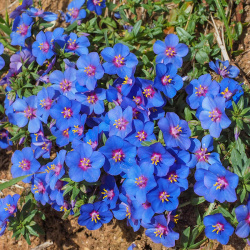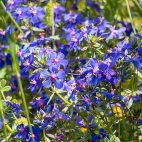Scarlet Pimpernel Seeds
Anagallis arvensis
- HOW TO GROW
- FAST FACTS
HOW TO GROW
Sowing: Scarlet Pimpernel does not transplant well, and should be direct sown for best results. In fall or early spring, direct sow groups of 2-3 seeds. Cover very lightly, since light is required for germination. These seeds germinate at temperatures from 55-70 degrees F, sprouting in 30 to 45 days.
Growing: Keep seedlings watered until they become established; mature plants only need water in drought conditions. This plant grows best in full sun and sandy or rocky soil, but adapts to well-drained soil. Though not invasive, this plant will reseed itself and spread to form a ground cover. Volunteer plants can easily be removed if they are unwanted. This plant also grows well as a long blooming container plant or a ground cover. Deer resistant.
Harvesting: Scarlet Pimpernel can be toxic even in small amounts, and is not recommended for medicinal or culinary use.
Seed Saving: These plants produce seed for most of the summer, since they bloom from spring to fall. When the flowers fade, seed pods will form. Since the pods split and drop their seeds when completely ripe, the pods should be gathered individually as soon as they begin to dry. Before harvesting, check the pods to make sure the seeds have reached their mature dark brown or black color. Spread the seed pods out to finish drying away from direct sunlight; thresh them to remove the seed. Store the seed in a cool, dry place for 8 years.
FAST FACTS
Common Names: Red Pimpernel, Red Chickweed, Poor Man's Barometer, Poor Man's Weather-Glass, Shepherd's Weather Glass or Shepherd's Clock
Latin Name: Anagallis arvensis
Species Origin: Europe
Type: Garden Flowers
Life Cycle: Annual
USDA Zones: 1, 2, 3, 4, 5, 6, 7, 8, 9, 10, 11, 12
US Regions: California, Mountain, Arid/Desert, Plains/Texas, Midwest, Northern, Northeast, Southeast
Seeds per Ounce: 39,200
Stratification: No Stratification
Germination Ease: No Stratification
Sunlight: Full Sun
Height: 6 Inches
Color: Red
Bloom Season: Blooms Late Spring, Blooms Early Summer, Blooms Late Summer, Blooms Early Fall
Uses: Deer Resistant
DESCRIPTION
HOW TO GROW
Sowing: Scarlet Pimpernel does not transplant well, and should be direct sown for best results. In fall or early spring, direct sow groups of 2-3 seeds. Cover very lightly, since light is required for germination. These seeds germinate at temperatures from 55-70 degrees F, sprouting in 30 to 45 days.
Growing: Keep seedlings watered until they become established; mature plants only need water in drought conditions. This plant grows best in full sun and sandy or rocky soil, but adapts to well-drained soil. Though not invasive, this plant will reseed itself and spread to form a ground cover. Volunteer plants can easily be removed if they are unwanted. This plant also grows well as a long blooming container plant or a ground cover. Deer resistant.
Harvesting: Scarlet Pimpernel can be toxic even in small amounts, and is not recommended for medicinal or culinary use.
Seed Saving: These plants produce seed for most of the summer, since they bloom from spring to fall. When the flowers fade, seed pods will form. Since the pods split and drop their seeds when completely ripe, the pods should be gathered individually as soon as they begin to dry. Before harvesting, check the pods to make sure the seeds have reached their mature dark brown or black color. Spread the seed pods out to finish drying away from direct sunlight; thresh them to remove the seed. Store the seed in a cool, dry place for 8 years.
FAST FACTS
Common Names: Red Pimpernel, Red Chickweed, Poor Man's Barometer, Poor Man's Weather-Glass, Shepherd's Weather Glass or Shepherd's Clock
Latin Name: Anagallis arvensis
Species Origin: Europe
Type: Garden Flowers
Life Cycle: Annual
USDA Zones: 1, 2, 3, 4, 5, 6, 7, 8, 9, 10, 11, 12
US Regions: California, Mountain, Arid/Desert, Plains/Texas, Midwest, Northern, Northeast, Southeast
Seeds per Ounce: 39,200
Stratification: No Stratification
Germination Ease: No Stratification
Sunlight: Full Sun
Height: 6 Inches
Color: Red
Bloom Season: Blooms Late Spring, Blooms Early Summer, Blooms Late Summer, Blooms Early Fall
Uses: Deer Resistant
Also Consider These:
-
 Out of Stock
Blue Pimpernel Seeds
Anagallis monelli
Quick View
x
Out of Stock
Blue Pimpernel Seeds
Anagallis monelli
Quick View
xBlue Pimpernel Seeds
Anagallis monelli
One of the brightest, truest blues in nature, these eye-catching flowers originally grew wild along the rocky slopes and sand dunes of the Mediterranean coast. This annual is a lovely choice for hanging baskets or an annual wildflower planting.
Starting at $2.98 USD







